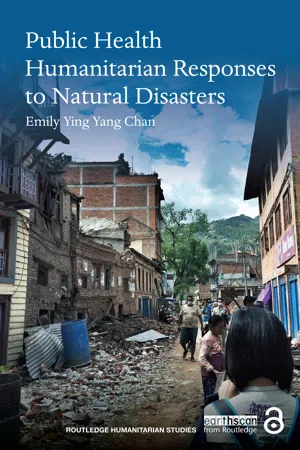Impacts of Hazards
The impacts of hazards refer to the effects that natural or human-induced disasters have on people, the environment, and infrastructure. These impacts can include loss of life, damage to property, disruption of essential services, and long-term social and economic consequences. Understanding and mitigating these impacts is crucial for effective disaster management and resilience building.
3 Key excerpts on "Impacts of Hazards"
- eBook - ePub
Human Geography
An Essential Introduction
- Mark Boyle(Author)
- 2021(Publication Date)
- Wiley-Blackwell(Publisher)
...This rings true also for societal and technological hazards. Hazards are inherently riskier for impoverished, powerless, and disadvantaged populations – in reality, the poor, women, the less educated, those socially isolated, ethnic minorities, people with disabilities, and children, especially, although not exclusively, in the developing world. Social, political, and economic precarity renders some populations especially vulnerable, leaving them without the capacity to limit danger through forward planning, and making them more susceptible to the harmful effects of a shock and less able to cope when perturbation strikes. The pioneering work of Canadian geographer Kenneth Hewitt also encouraged human geographers to begin to take seriously the role of society in increasing and aggravating the lethality of natural hazards. In his 1983 book Interpretations of Calamity: From the Viewpoint of Human Ecology (Hewitt 1983), Hewitt demonstrated that natural hazards are always threatening but only develop into calamities when societies pursue development pathways that unwittingly increase their vulnerability. In his book Regions of Risk: A Geographical Introduction to Hazards, published in 1997, Hewitt elaborated on this claim by showing that calamity results from three factors: the natural hazard itself, the vulnerability of societies, and the degree to which societies are active in defending themselves. In the early 1990s, British geographers Keith Smith and David N...
- eBook - ePub
- Dina Ionesco, Daria Mokhnacheva, François Gemenne(Authors)
- 2016(Publication Date)
- Routledge(Publisher)
...Human activities may also result in sudden-onset disasters, such as nuclear or industrial accidents, flash floods resulting from sudden water release from dams, or landslides associated with construction projects, all of which can have grave effects on communities. As the world's population increases, a growing number of people live in areas prone to hazards, whether sudden or slow onset, All geographic regions and localities experience some or other type of environmental change or stress; but some areas are particularly disadvantaged, both in terms of exposure of population and key infrastructures and assets to hazards, as well as in terms of local capacity to respond to adversity and to recover from disasters, which is often more limited in lower income countries. Climate change Greenhouse gas emissions from human activities since the nineteenth century have had a significant impact on the climate and weather systems. The development of transport, industry and new technologies reliant on fossil fuels, intense extraction of natural resources, mass deforestation and greater agricultural production to feed the growing population of the planet have all contributed to increasing the amount of carbon dioxide, methane and other gases released into the atmosphere, leading to its warming at an unprecedented rate. Climate change is now considered unequivocal by scientists, and is associated with increased global air and sea temperatures, changing precipitation patterns, melting glaciers and permafrost, the acidification of oceans, rising sea levels, and the growing frequency and intensity of meteorological, hydrological and climatological hazards. These changes inevitably disturb ecological, social and economic systems, exacerbating existing vulnerabilities, and affecting livelihoods, human security and human rights...
- Emily Ying Yang Chan(Author)
- 2017(Publication Date)
- Routledge(Publisher)
...4 THE SPECIFIC HUMAN HEALTH IMPACTS OF NATURAL DISASTERS DOI: 10.4324/9781315667218-5 The human health impact of natural disasters varies according to the risk factors associated with the specific hazards, exposure and community vulnerabilities. Health impact caused by earthquakes, tsunamis, volcanic eruptions, floods, extreme temperature events, cyclones, droughts and famines will be discussed in this chapter. Geophysical hazards: earthquake and tsunami An earthquake is a geophysical event caused by seismic waves which lead to the shaking and displacement of the ground. It is the result of a sudden release of energy stored in the earth’s crust. During an earthquake, individuals located in places near the epicentre can feel the shaking or displacement of the ground (Centre for Research on the Epidemiology of Disasters [CRED], 2009). Aftershocks are also caused by seismic waves after the major earthquake and might be of similar and lesser intensity. Tsunamis are a specific by-product of earthquakes, which originate beneath the ocean floor. A tsunami may produce high waves, which approach the shoreline. The health impact of a tsunami is similar to that of a flash flood, which will be discussed in a later section. How is it reported? The Richter scale is the most commonly used scale to report the strength or the amount of energy released by an earthquake. It is calculated from the amplitude of the largest seismic wave recorded for a given earthquake and reported on a logarithmic scale. For each whole number increment of the Richter scale score, the strength of the earthquake increases ten times. A level-8 earthquake on the Richter scale is ten times stronger than a level-7 earthquake. However, the Richter KNOWLEDGE BOX 4.1 THE MODIFIED MERCALLI SCALE AND RICHTER SCALE Table 4.1 draws an approximate parallel between the modified Mercalli scale and the Richter scale based on the records of past earthquakes...


